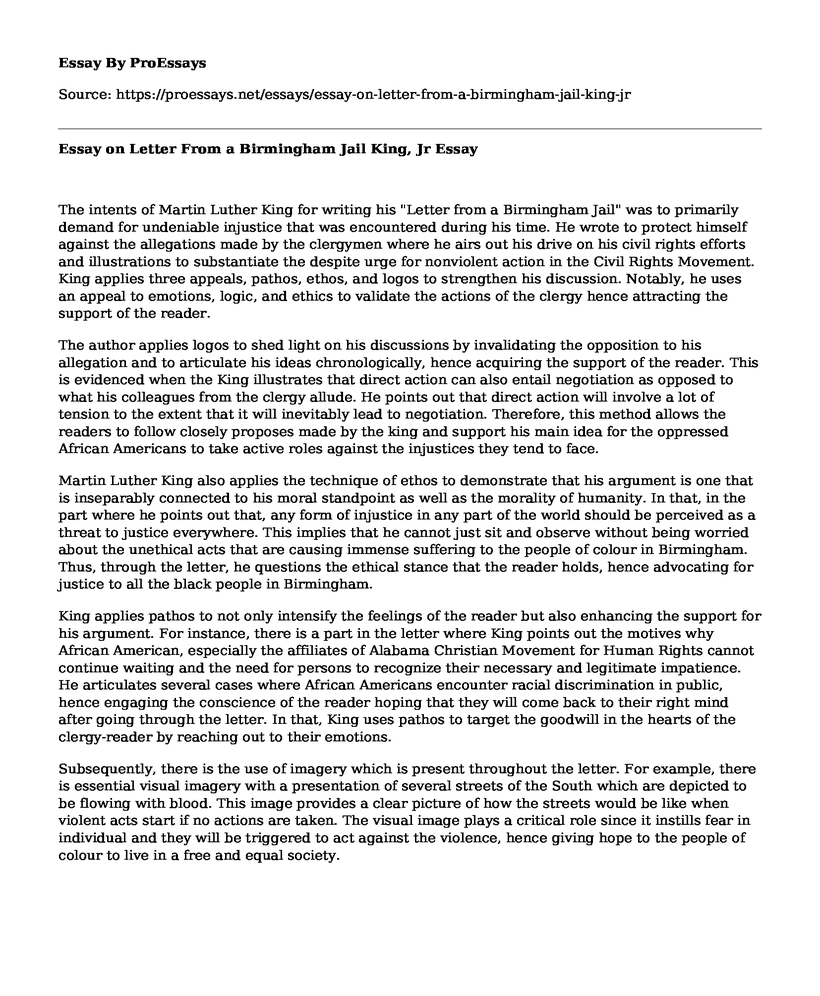The intents of Martin Luther King for writing his "Letter from a Birmingham Jail" was to primarily demand for undeniable injustice that was encountered during his time. He wrote to protect himself against the allegations made by the clergymen where he airs out his drive on his civil rights efforts and illustrations to substantiate the despite urge for nonviolent action in the Civil Rights Movement. King applies three appeals, pathos, ethos, and logos to strengthen his discussion. Notably, he uses an appeal to emotions, logic, and ethics to validate the actions of the clergy hence attracting the support of the reader.
The author applies logos to shed light on his discussions by invalidating the opposition to his allegation and to articulate his ideas chronologically, hence acquiring the support of the reader. This is evidenced when the King illustrates that direct action can also entail negotiation as opposed to what his colleagues from the clergy allude. He points out that direct action will involve a lot of tension to the extent that it will inevitably lead to negotiation. Therefore, this method allows the readers to follow closely proposes made by the king and support his main idea for the oppressed African Americans to take active roles against the injustices they tend to face.
Martin Luther King also applies the technique of ethos to demonstrate that his argument is one that is inseparably connected to his moral standpoint as well as the morality of humanity. In that, in the part where he points out that, any form of injustice in any part of the world should be perceived as a threat to justice everywhere. This implies that he cannot just sit and observe without being worried about the unethical acts that are causing immense suffering to the people of colour in Birmingham. Thus, through the letter, he questions the ethical stance that the reader holds, hence advocating for justice to all the black people in Birmingham.
King applies pathos to not only intensify the feelings of the reader but also enhancing the support for his argument. For instance, there is a part in the letter where King points out the motives why African American, especially the affiliates of Alabama Christian Movement for Human Rights cannot continue waiting and the need for persons to recognize their necessary and legitimate impatience. He articulates several cases where African Americans encounter racial discrimination in public, hence engaging the conscience of the reader hoping that they will come back to their right mind after going through the letter. In that, King uses pathos to target the goodwill in the hearts of the clergy-reader by reaching out to their emotions.
Subsequently, there is the use of imagery which is present throughout the letter. For example, there is essential visual imagery with a presentation of several streets of the South which are depicted to be flowing with blood. This image provides a clear picture of how the streets would be like when violent acts start if no actions are taken. The visual image plays a critical role since it instills fear in individual and they will be triggered to act against the violence, hence giving hope to the people of colour to live in a free and equal society.
Conclusion
To sum up, it is evident that the King's letter is full of ethos, pathos, and logos which are some of the techniques applied to strengthen his argument. Therefore, he applies figurative language, imagery, illusions amongst other styles to convey his message of building a future that has no form of discrimination. As witnessed in this rhetorical analysis, it is evident that Dr. Martin Luther King Jr. is gifted as a writer and his immense support of the Civil Rights Movement which advocates for justice especially for the oppressed members in the society.
Cite this page
Essay on Letter From a Birmingham Jail King, Jr. (2022, Dec 21). Retrieved from https://proessays.net/essays/essay-on-letter-from-a-birmingham-jail-king-jr
If you are the original author of this essay and no longer wish to have it published on the ProEssays website, please click below to request its removal:
- "Due Process" in The Crucible by Arthur Miller Essay
- Poetry Analysis Essay on Daystar by Rita Dove
- A Letter to Her Husband, Absent Upon Public Employment by Anne Bradstreet Essay
- The Journey From Slavery to Freedom in 'Incidents in the Life of a Slave Girl' Essay
- Critical Essay on Hamlet Play by Shakespeare
- Article Analysis Essay on There May Be Flowing Water on Mars but Is There Intelligent Life on Earth?
- Literary Analysis Essay on "Everyday Use" and "Dead Men's Path"







